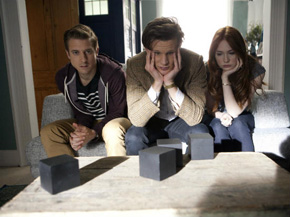|
|
TV Recap: Doctor Who - The Power of ThreeBy Edwin DaviesSeptember 24, 2012
As far as that story goes, it is at least built around a novel idea, albeit one that winds up amounting to very little: an invasion that doesn't seem to be an invasion at all. Millions upon millions of little black cubes appear one day, in locations across the world, and no one can figure out what they are, not even Professor Brian Cox! (People often talk about the way in which the show has started to court the American market more in recent years, something which perhaps not coincidentally has occurred at the same time that it has begun to build a sizable audience on BBC America, but this episode was surprisingly heavy on figures from British popular culture whose presence might mystify the American audience.) There's only one man (Time Lord, whatever) for the job, and The Doctor gets right down to the nitty-gritty. However, despite his best efforts, he also fails to figure out what the cubes are for or do, but senses that there must be something going on, and he hangs around to figure out what that something is. It turns out that the cubes are a monitoring device for an alien race who want to assess mankind's weaknesses in order to conquer them, and to do this they introduce the cubes, then have them remain largely inactive until such a point that people forget about them and they become part of the fabric of everyday life. (People even start to use them as paperweights.) This takes them the better part of a year, which is why Amy describes it as "The Slow Invasion," and so forces The Doctor to do something he hasn't done before: spend some time as part of Amy and Rory's life on Earth.
|

|
|
|

|
Tuesday, April 23, 2024
© 2024 Box Office Prophets, a division of One Of Us, Inc.


